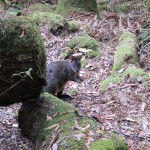
One of the great pleasures of hiking in the woods (or bush, as they say in Oz) is coming upon elusive wildlife. Anyone who has visited Yellowstone or seen deer grazing in Colorado knows this delight. It’s just as fine to welcome such animals when you occupy a cottage in the woods and they come calling.
If you’re attentive, you’ll typically see birds most frequently, as larger animals can be much more reclusive. We’re middling-class birdwatchers ourselves, always listening for a trill or coo, with binoculars at the ready. We love the challenge of spying them hiding in thick leaves – and identifying them – but we’re just starting to learn which species you can find down here in Oz, like the Laughing Kookaburra or the lovely honeyeaters.
The tougher animals to find in Tasmania are the native mammals, particularly since most of them are nocturnal. That’s why so many people at Cradle Mountain National Park wander the roads at dusk (and probably at dawn, though we didn’t quite get up early enough). Like us peering through the brush for birds, these people are just trying to catch a glimpse of the local animals. We actually did a bit of night prowling there, but couldn’t see doing the night safari tour on offer. What’s the fun of riding in a monster truck while it flails its spotlights up and down the trees of the main roadway? Besides, on the evening we might have done this, we heard that this incandescent tour found only the same animals we had seen on our own.
And we had seen quite a few, fortunately.
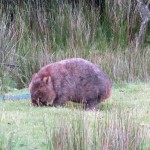
In our hikes, we encountered a number of pademelons (small wallabies) and larger wallabies (the rufous or Bennett’s) that can be confused with the even larger kangaroo. On two evenings at Cradle Mountain, just before dark, we were thrilled to find a wombat determinedly munching on juicy grasses near the parking lot of the Visitor Center. Yes, there really is an animal called the wombat! It’s a bit hard to tell which end is which on a wombat. The rotund face blends into a neck-less body of brownish-grey fur, shaped like a squat meter-long football. It looks a bit like a small bear or hunched, fattened koala (its nearest relative). When we seemed too nosy or too close, our wombat ambled off a bit faster than we expected for a fur-ball on short legs, and vanished into the nearby dark thicket where he probably slept during the day. Otherwise, he just continued to chew noisily, shifting forward just a few inches at a time, unconcerned by our presence.
The wilderness cabins in which we stayed drew a lot of other animals toward us.

In the bush reserves of the Huon River Valley, our porch looked out upon the backyard of various birds and mammals. Until dusk, we tracked several small birds like the “superb fairy wren” (yes, that’s its name) with a striking facial pattern of dark and light blue, as well as larger ones like the noisy green rosellas (parrots).

We admired the huge yellow-tailed black cockatoos, blushing yellow also on their cheeks and squawking overhead in raucous groups.
Before long, we heard a great rustling in the undergrowth and suddenly there was our first pademelon, hopping and scooting on the lawn.

As long as we were quiet and unthreatening, he tasted the grasses about us without much concern. Later that night, we slipped out barefoot in the dark to see the Milky Way a-glitter in the night sky. Suddenly Barry felt a nibble on his toes, and we made a bee-line to shelter. Torch (flashlight) in hand, we scanned the ground beyond the porch to find a brush-tailed possum before us.

About the size of a cat, he ambled onto the deck, about two feet of dark bushy hair with another foot of bushy tail behind and a pink rodent snout. We tried to scare him off, with flashing lights, threatening noises, and lots of wild arm flailing. Is “shoo” really a good anti-possum cry? But he was brazen, rushing toward the sliding glass doors when we opened them, rather than away from us. We pulled the curtain and ceded him sway over the yard.

At Cradle Mountain, the area around our cabin in the woods attracted even more attention as we sat on the deck four feet above the ground. Two pademelons crunched amid the fallen leaves, the bigger one frequently chasing the smaller off a few meters. A second evening, the returning pademelon was soon joined by a rufous wallaby. After a while, three black silhouettes flapped noisily onto nearby trees. This bird, the black currawong, looks a bit like a raven, but with a larger, almost conical dark beak and white splashed on the tail. One boldly took up position on the railing and soon dropped down to peck away at the floor and scavenge anything left over. The trio spooked easily though, and soon disappeared into the remote trees. A bit later we heard the screech of a Tasmanian Devil in the vicinity, or so we thought.
As it darkened further, we heard the wallaby crunching the dry leaves again, but that sound turned into more of a scratching below the deck, and then – what’s that? – the wallaby sounded like it was climbing up the porch columns. Not a wallaby, it turned out, but, this time, two brush-tailed possums suddenly popped onto the rail. We had learned from discussing our first experience with the lodge manager that we need not fear rabies from these, but they prove quite an annoyance for Australians generally.
Once again the possums were undisturbed by our noise-making or our feebly aggresive motions. Finally, we picked up deck chairs and chased one off as if we were lion-tamers. Shifting attention to the second, we prodded him back to the railing. There, before scooting off for easier pickings, he dismissively lifted his tail and urinated on the deck.
True to form, though, one reappeared later, unperturbed by our presence inside the glass door and apparently longing to join us where the good food could be had. He too did not take rejection well either: the next morning we found on our lion-taming chairs a good size deposit of possum droppings.
In the wild, unfortunately, we were not able to see two other iconic Australian marsupials from Tasmania: the Tasmanian Devil, though we might have heard one, and the platypus. So we did the next best thing, visit conservation shelters.
The big advantage of visiting a shelter is that you learn quite a bit about the nature of these animals and their often unusual ways. For example, the adult male platypus has small, bony “spurs” underneath just inside his hind legs that can pierce a rival and inject deadly venom. There is no protection from this venom, unlike for snake species, since every platypus produces a biologically unique version. Paying admission at the shelters, we also happily support dedicated efforts to rescue, promote and preserve the species.
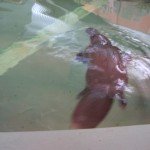
Our first shelter was the Platypus House, on Beauty Bay upriver of Launceston. These animals had been rescued from traps and illness, and were now housed grandly in elaborate man-made ponds and imitation burrows. In the wild, they’re generally tough to spot even with insider information, such as the not-so-subtly named viewing area at Platypus Bay in Lake St. Clair.

A platypus in the wild uses a tunnel to hide in a daytime burrow out of the water, as well as to a nighttime burrow, so they often hide themselves away. Of course, their habitats in the shelter needed to mimic those features, so the caretakers had constructed long tunnels running back and forth between rooms. Since the platypus is naturally solitary, each required its own tank and tunnels.
In their glassed pools, you could watch them briefly glide along the surface, their bellies buoyant below the waterline, then – what you also could not see in the wild – they would dive down with the push of their webbed paws to find food. They constantly wiggle their duck-billed heads back and forth like magic wands, since their eyes are closed and they find food through smell, not sight.

For an extra treat, the shelter also housed a number of their prickly cousins, the echidnas, compact balls of spine-covered fur with a pointed snout and long anteater tongue. We had already seen one of these waddling on his inverted paws by the side of the road, but not up close until our hike later at Lake St. Clair when we found one doggedly tonguing an ant colony on the trail in front of us, to the evident delight of two young Swedish women.
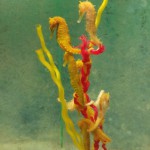
On offer next to the Platypus House was the only place in the world that breeds sea horses, who are also a bit hard to see from above the water. Though the little creatures in the facility were available for scientific study and testing, the staff were in effect wranglers breeding sea horses for aquariums around the world.
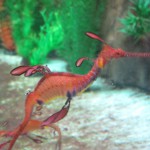
On display were hundreds of particularly colorful varieties, floating gracefully up and down, wrapping their tails around braids and coral and even other sea horses. In the main tanks out back, sea horses kept producing vast herds of new sea horses in their watery corrals.
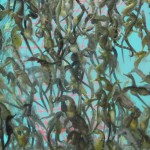
A recent crop of sea foals looked like specks of dirt until you peered very closely and saw they were nano-sea horses, very tiny but full-fledged versions of their parents. Most large tanks held dozens of these creatures, but some must have held thousands in a tangle of horseflesh that mimicked Medusa’s snaky hair.
The last shelter we visited featured the famous Tasmanian Devils, the symbol of the Tasmanian Parks and Wildlife department, at Cradle Mountain. Let’s face it. Though we might have heard one yell, everyone who visits here wants to see a Devil, including us, but most likely won’t except in a shelter. Sadly, they are no longer plentiful on the island, and have almost disappeared in the east. The main reason is a strange facial virus that causes fatal cancerous lesions, but has no cure except to isolate the healthy ones from potential infection – as in the type of shelter we visited.
The Devil is one of only two predator mammals left in Australia. The other is the quoll (rhymes with hall), two species of which were also sheltered here. A third had been the Tasmanian Tiger, who looked like a greyhound with stripes, but is now presumed extinct as none have been sighted for decades.
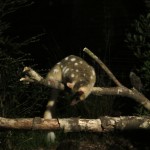
Quolls look like a tiny monkey or small fox. They are superb hunters: in a video they showed, a quoll pounced on a much larger wallaby and quickly cut its neck (the film showed a Devil then quickly stealing the carcass, but that turn was a bit of histrionic filmmaking apparently, not normal). Quolls are also endangered, but mainly through loss of habitat on the island. Nocturnal and very, very quick, we would likely never have seen one in the wild, so their presence was also a treat.
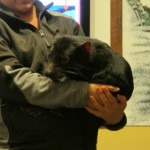
We loved the frisky, rambunctious quolls, but the Devils are the main event here. About the size of a terrier, they are hardly devilish in appearance, and can look at times rather cute. Our guide carried about in her arms one that even looked adorable and pet-like, though it was mostly raised among people. It was dark when we first saw the rest of them, a time when they are most active, and they were all trotting about amiably, when not lying peacefully in their dens.
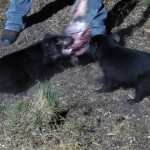
The Devils got their name, apparently, for three reasons. They can be fierce attackers of prey, though they mainly eat carrion in the wild. With perhaps the strongest jaws of any animal, they can bring down a small prey as well as the quoll, then they eat the entire carcass, bone and all.
Secondly, they are not communal. They fight viciously with each other over food. We watched two pint-sized Devils ripping and tearing a wallaby leg, a voracious feast only interrupted by a fierce tug-of-war with each other on the leg and snarling threats otherwise. (See the video below.)

Lastly, there’s the howl. They open their jaws in an odd wedge-like position, show their devilish canines and emit a brain-curdling screech that could frighten even the blessed saints.
Early on their keeper warned: “Don’t lower your arm over the enclosure.” We know we’re too large a prey for the Devils, and they don’t attack in packs. But once we saw them in hellish action, we were pleased we saw them penned up, not in the wild.
(Also, for more pictures from Australia, CLICK HERE to view the slideshow at the end of the Australia itinerary page.)
And more…the Devils shredding the leg and a bit of each other:


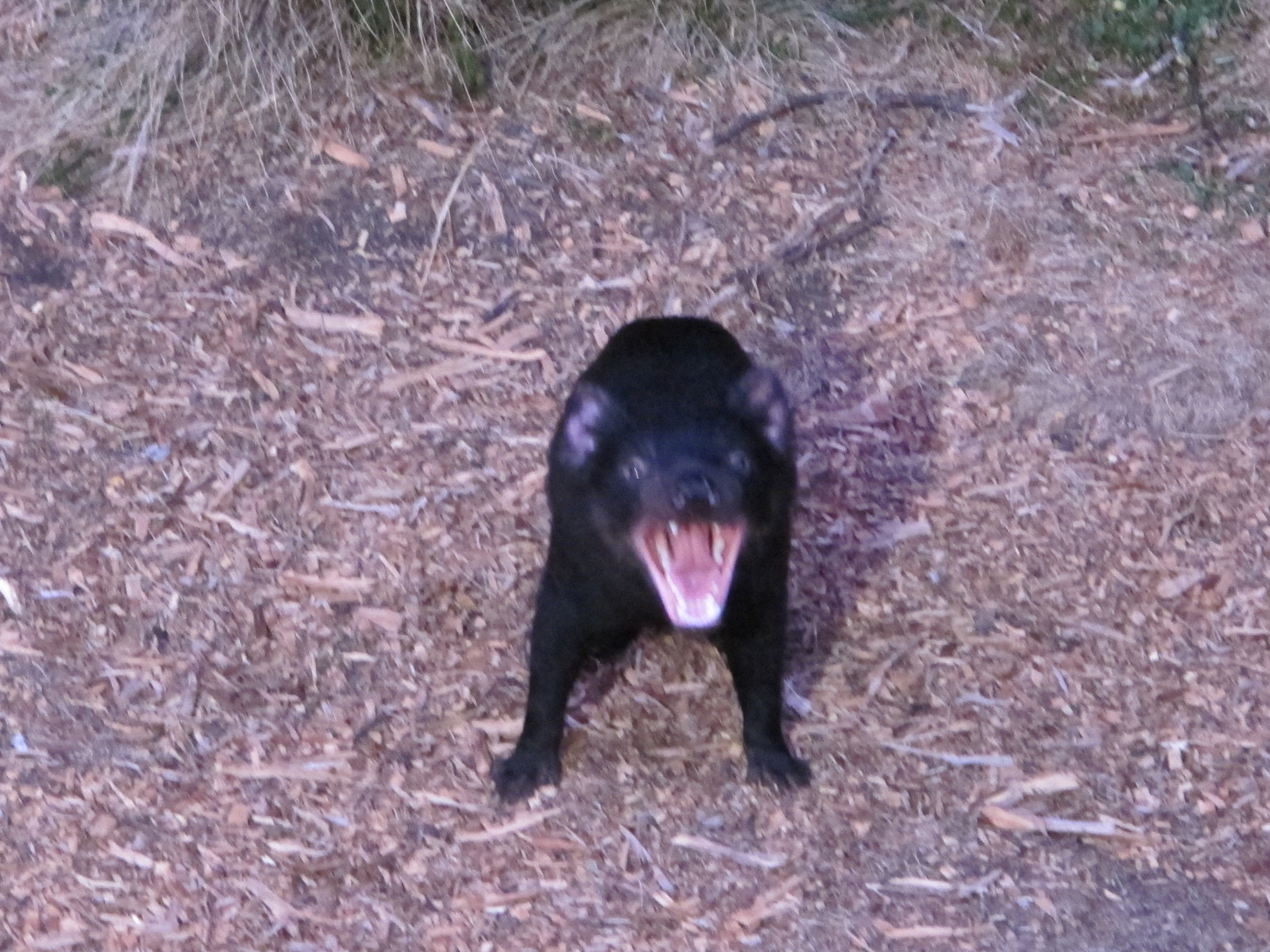

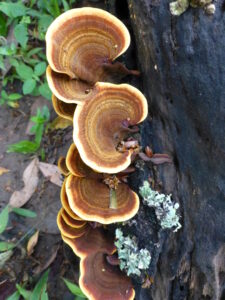

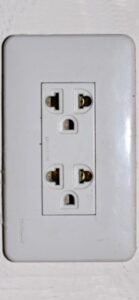
They don’t seem brazen, but I bet wombat tastes good. Can you eat them?
Wombats not brazen; possum very much so. Next time I see a wombat, I will ask one if it is flavorful. Tasmanian Devils seem to prefer wallabies, if that’s any indication.